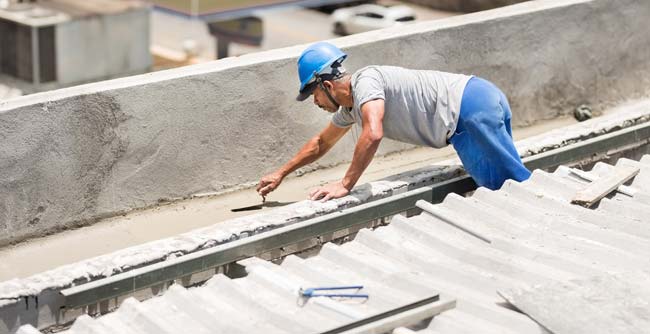Get a highly rated Sylvania Roofing Contractor for affordable roofing solutions.
Get a highly rated Sylvania Roofing Contractor for affordable roofing solutions.
Blog Article
Exactly How to Evaluate Different Roof Covering Choices for Your Building Needs
Evaluating roofing options for your building needs an extensive strategy that takes into consideration numerous factors such as the intended usage of the framework, regional environment conditions, and product features - Toledo Roofer. It is crucial to evaluate the advantages and downsides of various roof types, from asphalt roof shingles to steel and clay floor tiles, while likewise factoring in first expenses and long-term upkeep.
Assessing Your Structure's Needs
To successfully examine roof choices, begin by thoroughly assessing your building's needs. Start by thinking about the structure's meant usage, as different frameworks may necessitate differing roofing requirements. Residential roofing systems typically focus on visual appeals and insulation, while business buildings might focus on toughness and load-bearing capability.
Next, assess the neighborhood climate problems that will certainly influence roofing efficiency. Aspects such as temperature level variations, precipitation levels, and wind patterns can affect material selection and layout. A roof that masters a warm environment may not perform also in locations vulnerable to heavy snowfall or severe warm.
In addition, evaluate the architectural stability of your building. Ensure that the existing structure can support the chosen roofing products, specifically if thinking about much heavier options. It is additionally crucial to evaluate any type of regional building codes or laws that might dictate specific demands for roofing systems.

Contrasting Roofing Materials
As soon as a comprehensive assessment of your building's needs has been finished, the next step includes comparing various roof products. Each material uses distinct advantages and disadvantages, making it necessary to align your option with your specific needs and scenarios.
Asphalt tiles are widely identified for their cost and convenience of installation, making them a preferred alternative for domestic buildings. On the various other hand, metal roof, recognized for its resilience and longevity, can stand up to extreme climate problems yet may come with a greater first financial investment.
Clay and concrete tiles provide exceptional thermal insulation and visual appeal, particularly for Mediterranean-style architecture, yet they require an even more durable structural support due to their weight. Timber shakes deal an all-natural appearance and excellent insulation buildings however might require extra upkeep and are vulnerable to fire dangers.
Examining Cost and Spending Plan
Examining your roof covering alternatives necessitates a cautious assessment of expense and budget considerations. The total budget plan for a roof job comprises a number of aspects, including product costs, labor expenditures, upkeep, and prospective long-term cost savings. It is important to establish a clear budget plan before exploring particular roofing materials, as this will direct the decision-making process and help you prevent overspending.
Begin her latest blog by obtaining quotes from multiple service providers to understand labor expenses in your area. Make certain that these estimates consist of all required solutions, such as elimination of the old roofing system, setup, and any additional attributes, like insulation or air flow renovations - Toledo Roofer. Next off, helpful site assess the price of numerous roofing materials, thinking about both initial installment expenses and expected lifespan

Understanding Energy Efficiency
Energy efficiency plays an essential role in the selection of roofing products and systems, dramatically influencing both energy intake and overall comfort within a building. A well-chosen roofing system can improve thermal efficiency, lowering the need for home heating and cooling down systems, which in turn decreases power costs and decreases environmental impact.
When assessing roof alternatives, take into consideration materials that show instead than absorb heat. Light-colored or reflective roofing items can significantly lower roof covering surface area temperature levels, leading to reduced energy usage throughout warm months. Additionally, proper insulation and air flow are essential to optimize the energy efficiency of the whole roof system. Insulation stops warmth transfer, while air flow reduces heat build-up in the attic room room.
An additional vital factor is the roof's long life and upkeep demands. Resilient materials that require much less constant substitute add to long-term energy cost savings. In addition, the power effectiveness of a roof can likewise be examined through its compliance with well-known sustainability ratings such as ENERGY STAR or LEED.
Thinking About Visual Appeal
A roof's aesthetic allure significantly influences the overall look of a building, complementing its architectural design and boosting visual appeal. Roofing Contractor. When examining roof covering choices, it is necessary to think about how the picked material, color, and design will certainly integrate with the existing structure and neighborhood. A properly designed roof covering can elevate even the easiest of buildings, transforming them right company website into aesthetic prime focus
Various roof covering products use different aesthetic qualities. Typical tiles might stimulate a traditional beauty, while metal roof covering can present a modern, streamlined look. Furthermore, the shade of the roofing material plays a vital function; lighter shades can make a structure show up more sizable, while darker tones might produce a cozier setting.
Furthermore, architectural aspects, such as dormers and eaves, can enhance the roof's aesthetic impact. It is suggested to seek advice from with specialist designers or architects to make certain the chosen roof option aligns with the general style intent. Inevitably, a roofing should not only supply useful benefits however likewise contribute positively to the structure's aesthetic, mirroring the proprietor's preference and the personality of the surrounding environment.
Conclusion

Report this page